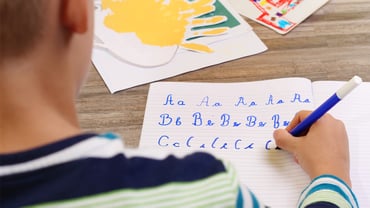Occupational therapists are experts at assessing the steps of an activity and modifying/adapting the steps in order for a child to perform at the highest level of independence. Occupational therapists work with children in a variety of settings, including in school. The following is a list is the first in a series of easy tips that parents and teachers can use when their students appear to be struggling.
Keep in mind, that there is a developmental scale for handwriting. Children between the ages of 5 and 6 should be able to copy a circle, a cross, and an X. They can crudely print their names at age 5. Letter reversal is common in children of this age. Between ages 6 and 7, children improve letter formation and overall penmanship abilities. By the end of first grade, children can copy from a blackboard and form a diamond. Between ages 7 and 8, children should be writing between 10-39 letters per minute with appropriate size/spacing. Reversals should be eliminated.
Writing and Classroom Tool Use
- If a child struggles with letter reversals, try teaching letters in groups (c,d,g,o, and q or t,l, f, h, and b) with similar formation starting points, or using different colors to visualize differences in strokes
- If a child has poor letter formation, practice writing the letters in the sky or in sand, trace over letter models with tracing paper, or tape letter formation models to the desktop
- If a child has poor spacing between letters and words, use graph paper (one letter/space per box), use “space men” (decorated popsicle stick spacers), or highlight margins to increase visual impact of where writing begins and ends
- If a child breaks pencils or tears paper when erasing, try using mechanical pencils, put something soft or textured under the paper, or tape paper to the wall and have the child write in a vertical plane
- If a child has an awkward grasp on a pencil, try using a golf pencil, write on a slant board, or use a rubber band on write and hook on the end of the pencil in order to pull it into the web space
- If a child has labored writing, space out the work sessions with short breaks, allow shortened answers, or allow the student to type or give answers orally
- If a child cannot color within the lines, make the outline thicker or darker, trace around the outline with glue and let it dry before they color, outline the shape with a wiki stix
- If a child has choppy/messy scissors skills, remind the student to hold scissors with “thumbs up”, use self-opening scissors, have them cut card-stock or thicker paper, and provide smaller sheets of paper to cut
If you are concerned with your child’s writing and classroom tool use, you may want to speak to your pediatrician about an occupational therapy evaluation.
8 Quick Handwriting Tips for Children Struggling in School
Nicole Newell, MS, OTR/L
Nicole Newell, MS OTR/L is the Clinical Director for Carolina Pediatric Therapy, a large, dynamic company that provides therapy to children across 18 counties of Western North Carolina. She graduated from Misericordia University in 1998 with a bachelor’s in psychology and a masters of occupational therapy. She has spent her 18 years as an occupational therapist specializing in sensory integration and treatment of children with autism.



